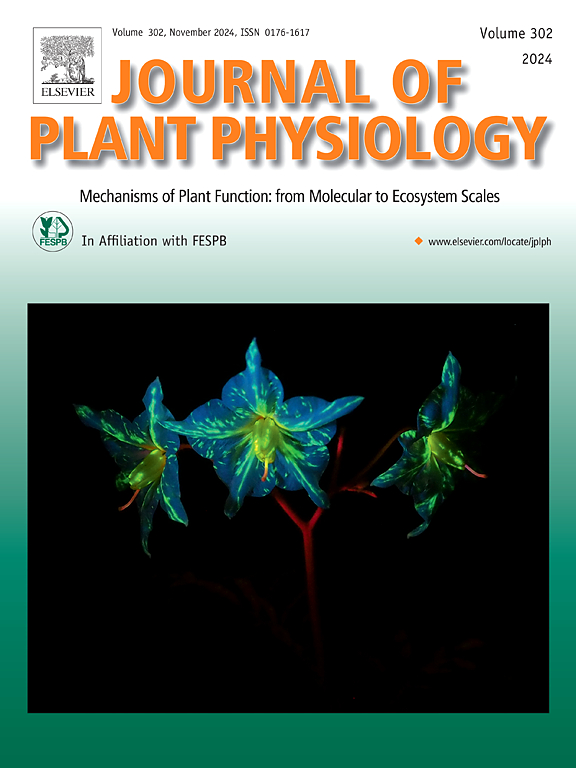Barley root tip peroxidases convert DAF-FM and DAR-4M to an NO-independent fluorescent product using H2O2 derived from polyamine catabolism by polyamine oxidases
IF 4.1
3区 生物学
Q1 PLANT SCIENCES
引用次数: 0
Abstract
The aim of our study was to investigate the possible involvement of barley root tip peroxidases and polyamine oxidases in the conversion of DAF-FM or DAR-4M into an NO-independent fluorescent product after the exogenous application of polyamines. Application of spermidine or spermine into the incubation medium increased H2O2 production by root tip segments in a dose-dependent manner. This spermidine- or spermine-induced increase in H2O2 production was accompanied by intensified fluorescence of both DAF-FM and DAR-4M in a polyamine dose-dependent manner, similarly to exogenously added H2O2. On the contrary, exogenous putrescine neither evoked H2O2 production nor increased DAF-FM or DAR-4M fluorescence. Application of guazatine, a polyamine oxidase inhibitor, into the incubation medium inhibited both H2O2 production and DAF-FM or DAR-4M fluorescence. Spermidine- or spermine-induced DAF-FM or DAR-4M fluorescence decreased with an increasing amount of catalase or guaiacol, a competitive substrate for peroxidase, in the incubation medium. Exogenous application of indole-3-acetic acid, a well-known activator of NO generation in roots, but not of H2O2, spermidine or spermine, induces NO accumulation in the root tips. Exogenous application of spermidine or spermine to plant tissues with high polyamine oxidase and peroxidase activity, as are the barley root tips, generates an NO-independent fluorescence signal from either DAF-FM or DAR-4M, giving a false positive signal for NO emission.
大麦根尖过氧化物酶利用多胺氧化酶分解代谢产生的H2O2将DAF-FM和DAR-4M转化为no独立的荧光产物
我们的研究旨在探讨大麦根尖过氧化物酶和多胺氧化酶在外源应用多胺后将 DAF-FM 或 DAR-4M 转化为不依赖于 NO 的荧光产物的过程中可能的参与作用。在培养基中加入亚精胺或精胺会以剂量依赖的方式增加根尖片段产生的 H2O2。与外源添加的 H2O2 相似,精胺或亚精胺诱导的 H2O2 生成增加也伴随着 DAF-FM 和 DAR-4M 荧光的增强,且呈多胺剂量依赖性。相反,外源性腐胺既不会诱发 H2O2 生成,也不会增加 DAF-FM 或 DAR-4M 的荧光。在培养基中加入多胺氧化酶抑制剂瓜扎汀可抑制 H2O2 的产生和 DAF-FM 或 DAR-4M 的荧光。随着培养基中过氧化氢酶或愈创木酚(过氧化物酶的竞争性底物)含量的增加,精胺或精胺诱导的 DAF-FM 或 DAR-4M 荧光也会减少。外源施用吲哚-3-乙酸(一种众所周知的根中 NO 生成激活剂),而不是 H2O2、亚精胺或精胺,会诱导根尖中 NO 的积累。在多胺氧化酶和过氧化物酶活性较高的植物组织(如大麦根尖)中外源施用亚精胺或精胺,会从 DAF-FM 或 DAR-4M 中产生与 NO 无关的荧光信号,从而产生 NO 发射的假阳性信号。
本文章由计算机程序翻译,如有差异,请以英文原文为准。
求助全文
约1分钟内获得全文
求助全文
来源期刊

Journal of plant physiology
生物-植物科学
CiteScore
7.20
自引率
4.70%
发文量
196
审稿时长
32 days
期刊介绍:
The Journal of Plant Physiology is a broad-spectrum journal that welcomes high-quality submissions in all major areas of plant physiology, including plant biochemistry, functional biotechnology, computational and synthetic plant biology, growth and development, photosynthesis and respiration, transport and translocation, plant-microbe interactions, biotic and abiotic stress. Studies are welcome at all levels of integration ranging from molecules and cells to organisms and their environments and are expected to use state-of-the-art methodologies. Pure gene expression studies are not within the focus of our journal. To be considered for publication, papers must significantly contribute to the mechanistic understanding of physiological processes, and not be merely descriptive, or confirmatory of previous results. We encourage the submission of papers that explore the physiology of non-model as well as accepted model species and those that bridge basic and applied research. For instance, studies on agricultural plants that show new physiological mechanisms to improve agricultural efficiency are welcome. Studies performed under uncontrolled situations (e.g. field conditions) not providing mechanistic insight will not be considered for publication.
The Journal of Plant Physiology publishes several types of articles: Original Research Articles, Reviews, Perspectives Articles, and Short Communications. Reviews and Perspectives will be solicited by the Editors; unsolicited reviews are also welcome but only from authors with a strong track record in the field of the review. Original research papers comprise the majority of published contributions.
 求助内容:
求助内容: 应助结果提醒方式:
应助结果提醒方式:


